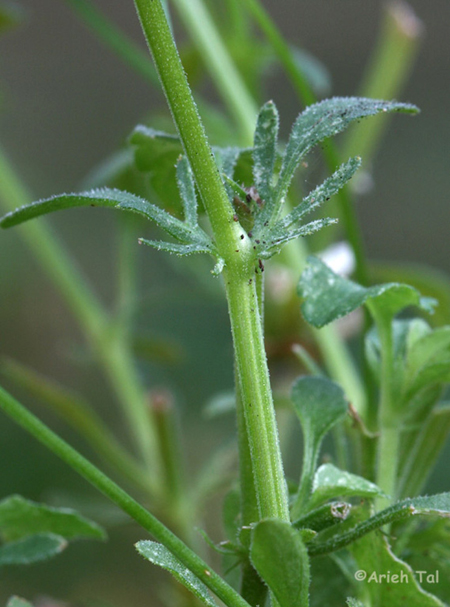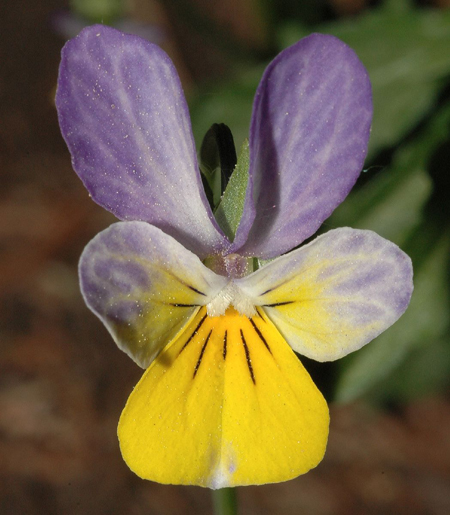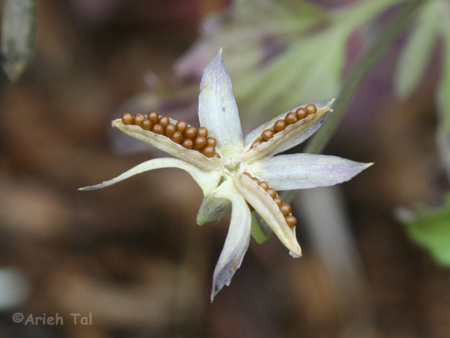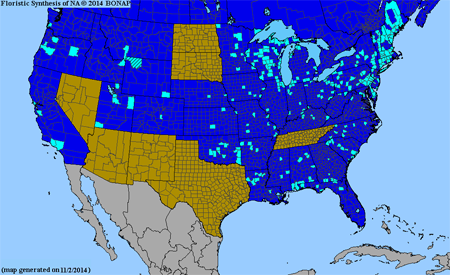Viola tricolor L.
Common names:
Heartsease, Johnny-jump-up
Synonyms (incomplete):
Viola tricolor L., Sp. pl., ed. 1, 2: 935. 1753; Mnemion tricolor Spach, Hist. Nat. Vég. (Spach) 5: 515. 1836
Description:
Caulescent annuals from slender to somewhat thick taproot, stems erect or declined at base, solitary or multiple, ≤ 35 mm tall; stems, foliage and peduncles light to medium green, quadrate stems recurved-puberulent on the angles, leaves sparsely to moderately hirtellous, peduncles glabrous; leaves cauline and commonly also basal; stipules free, deeply palmatifid, terminal lobe much larger than lateral lobes, elliptical, with (2–)4 or more crenations per margin; leaves ascending, leaf blades undivided, upper ≤ 38 × 10 mm, narrowly lanceolate to ovate-lanceolate, middle and lower ≤ 16 × 15 mm, smaller and often relatively broader (narrowly ovate to suborbicular), base narrowly cuneate to broadly rounded (rarely subcordate) and sometimes decurrent onto petiole and indistinct from it, margins crenate or serrate with 4–6 teeth on each side, ciliate, apex occasionally acute to mostly rounded; chasmogamous flower ≤ 18 mm, petals much longer than sepals; calyx glabrous (occasionally hispidulous), eciliate or ciliate; lowest sepals broadly lanceolate to ovate-lanceolate, sharply acute; auricles prominent, entire or erose, not elongating in fruit; corolla commonly with lower three petals yellow or pale purple and upper dark purple or purple-black, with a few slender black lines on lateral and spurred petal near base, throat yellow; spur slightly extending beyond the auricles, slender; lateral petals densely bearded with narrowly linear hairs, spurred petal glabrous; cleistogamous flowers lacking; capsule 6–10 mm, green drying tan, unspotted, glabrous; seeds 1.4–1.7 × 0.8–0.9 mm, medium to dark brown, unspotted; 2n=26.
Similar species:
This species is similar to the other two pansies in our region, introduced V. arvensis and native V. rafinesquei. It differs from V. arvensis in the palmatifid stipules, petals well surpassing the sepals, and the upper petals commonly purple-black or occasionally the whole corolla purple. It differs further from V. rafinesquei in the common presence of basal leaves, stipules with the terminal leaf-like lobe much larger and with 4 or more crenations per side, leaf blade much longer than broad and with 4 or more teeth per side, and corolla commonly cream with upper petals purple-black or occasionally with all purple petals.
Ecology:
Eurasian introduction, infrequently escaped from gardens and cemeteries.
Distribution:
Transcontinental but especially in the n. region, NL to AK, south to FL, TX and CA.
Rarity:
None.
Phenology:
Chasmogamous flower March–August (October), chasmogamous fruit April–August (September).
Affinities:
This species belongs to the Pansy lineage, sect. Melanium Ging.
Hybrids:
Hybridizes with V. arvensis, based on occasional plants in the field and on herbarium specimens with intermediate floral characteristics, such as distally purple-black upper petals but sepals about equaling the petals (Voss and Reznicek 2012, Harvey Ballard pers. comm.).
Comments:
Brainerd (1921b) did not mention this introduced species, and Brainerd Baird (1942) noted it but did not discuss it. Fernald (1950), Henry (1953a), Alexander (1963), Russell (1965), Scoggan (1978), Swink and Wilhelm (1979), Gleason and Cronquist (1991), Ballard (1995, 2000, 2013), McKinney and Russell (2002), Haines et al. (2011), Voss and Reznicek (2012), and Little and McKinney (2015) reported this species. Russell and McKinney and Russell indicated that it does not persist; and Russell, Scoggan and Ballard included V. ×wittrockiana with it. While the latter appears to be rarely collected and almost certainly does not persist very long following abandonment of its garden environment, the same does not appear to be the case with V. tricolor. Specimens of V. tricolorare widely distributed and often taken in disturbed areas somewhat removed from the nearest likely local seed sources. I have observed V. tricolor growing plentifully along roadsides near an old cemetery and in a disturbed oak barrens area with V. rafinesquei at the back of a cemetery in Athens County, Ohio, for approximately 20 years with no observable decline. This species is easily distinguished from V. arvensis by the somewhat larger flowers and much shorter sepals (the sepals several millimeters shorter than the petal apices) and the more elliptical leaf blades and terminal stipule lobes. It is readily separable from our native pansy, V. rafinesquei by its basal leaves, the typical three lower yellow or pale purple petals and dark purple or purple-black upper petals, more prominently crenulate margins on leaf blades and terminal stipule lobes, and absence of cleistogamous flowers and fruits. Either or both of the introduced species are rarely found growing with V. rafinesquei.
Literature Cited:
Alexander, E. J. 1963. Violaceae. In Gleason, H. A., The new Britton and Brown illustrated flora of the northeastern United States and adjacent Canada. Hafner Publishing Co., Inc., New York, NY. 552-567.
Ballard Jr., H. E. 1995 ["1994"]. Violets of Michigan. Michigan Botanist 33: 131-199.
Ballard Jr., H. E. 2000. Violaceae. In Rhoads, A. (ed.). Flora of Pennsylvania. University of Pennsylvania Press, Philadelphia, PA. 700-710.
Ballard Jr., H. E. 2013. Violaceae. In Yatskievych, G., Flora of Missouri. Missouri Botanical Garden Press, St. Louis, MO. 1218-1243.
Brainerd, E. 1921b. Violets of North America. Vermont Agricultural Experiment Station Bulletin 224: 1-172.
Brainerd Baird, V. 1942. Wild violets of North America. University of California Press, Berkeley, CA.
Fernald, M. L. 1950. Violaceae. In Gray's Manual of Botany, 8th ed. American Book Company, New York, NY. 1022-1042.
Gleason, H. A., and A. Cronquist. 1991. Violaceae. In Manual of vascular plants of northeastern United States and adjacent Canada, 2nd ed. New York Botanical Garden, Bronx, NY. 157-163.
Haines, A., E. Farnsworth, and G. Morrison. 2011. Violaceae. In Flora Novae Angliae. Yale University Press, New Haven, CT. 873-886.
Henry, L. K. 1953a. The Violaceae in western Pennsylvania. Castanea 18(2): 37-59.
Little, R. J., and L. E. McKinney. 2015. Violaceae. In Flora of North America: Cucurbitaceae to Droseraceae, 106. Oxford University Press, New York, NY.
McKinney, L. E., and N. H. Russell. 2002. Violaceae of the southeastern United States. Castanea 67: 369-379.
Russell, N. H. 1965. Violets (Viola) of the central and eastern United States: An introductory survey. Sida 2: 1-113.
Scoggan, H. J. 1978. Violaceae. In Flora of Canada, Part 3–Dicotyledoneae (Saururaceae to Violaceae). National Museums of Canada. Ottawa, Canada. 1103-1115.
Swink, F., and G. Wilhelm. 1979. Violaceae. In Plants of the Chicago region, 2nd ed. revised and expanded. Morton Arboretum, Lisle, IL. 384, 801-810.
Voss, E. G., and A. A. Reznicek. 2012. Violaceae. In Field manual of Michigan flora. The University of Michigan Press, Ann Arbor, MI. 913-922.

Chasmogamous flowering habit (plant at NY, Tompkins Co., Ithaca, Cornell University Plantations, Rock Garden area near entrance, 24 May 2006) by Kevin Nixon, "PlantSystematics.org" website

Leaves by Arieh Tal, "Go Botany" website, Native Plant Trust

Stems and stipules by Arieh Tal, "Go Botany" website, Native Plant Trust

Chasmogamous flower front view (plant at NY, Tompkins Co., Ithaca, Cornell University Plantations, Rock Garden area near entrance, 24 May 2006) by Kevin Nixon, "PlantSystematics.org" website

Chasmogamous flower profile view by Arieh Tal, "Go Botany" website, Native Plant Trust

Chasmogamous fruit by Arieh Tal, "Go Botany" website, Native Plant Trust

Map by the Biota of North America Program